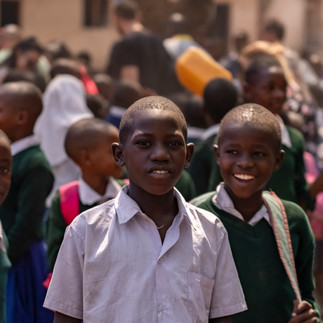Kenya and Tanzania: an unforgettable journey
- gimmycarpanzano
- Apr 11
- 6 min read
This is an adventure in the heart of East Africa, between Kenya and Tanzania , where the Rift Valley splits the earth like an ancient scar and time slows down, leaving room for the wonder of nature.
It all started at Nairobi airport, where we were greeted by our traveling companion: a sturdy 4x4 truck that we nicknamed Armadillo.
As soon as we leave Nairobi, the landscape changes. Skyscrapers and traffic give way to rolling hills and villages that seem to emerge from nowhere. We cross the Equator line, a simple gesture, but full of meaning: from here our journey truly begins. That same evening we pitch our tents at the Umoja Campsite , on the quiet banks of the Ewaso Nyiro River. Then a dinner under the African stars, between local flavors and new confidences, and time begins to flow with a new rhythm, slowly like the river next to us.
The next day we enter the Samburu National Reserve . An authentic place, far from mass tourism, where nature shows itself in all its power. The first safari leaves us breathless: giraffes, lions, elephants… one of them decides to get too close, and for a moment our hearts stop.
Next to the park we meet the Samburu , the “butterfly people”. They welcome us with colorful dances and intense smiles. We enter their villages, observe ancient gestures, listen to stories passed down by word of mouth. The Samburu are nomadic shepherds, proud guardians of a thousand-year-old culture. Their bond with the land and with their livestock is profound, almost sacred. They wear elaborate jewelry and brightly colored clothes that tell their identity.

We set off again towards the south, along dusty roads and endless panoramas. We stop at Thompson Falls , an imposing waterfall 74 meters high, fed by the Ewaso Nyiro River. It is located near the town of Nyahururu, on the central plateau of Kenya, at over 2,300 meters above sea level. The cool climate and lush vegetation make this place a surprising corner, far from the typical image of the savannah. In the evening we reach Lake Naivasha , where the night welcomes us with the silence of the hippos that observe us from afar.
At dawn we board a boat and, sailing slowly, we see hippos surfacing a few meters from us and birds flying low over the water intent on hunting.
We land on Crescent Island , a small crescent-shaped peninsula, now a private nature reserve. Here we embark on a walking safari, among giraffes, zebras, gazelles and antelopes that graze freely and peacefully. There are no predators, and we can move safely, observing the fauna up close.
This place has also been a film set: some scenes from the famous film Out of Africa were shot right here.

In the afternoon we move to Hell's Gate . This national park takes its name from a narrow gorge with sheer walls, once an active crack in the earth's crust, which connected Lake Naivasha to the volcanic activity of the interior. We cycle through these canyons in one of the few African parks where it is possible to go on a bike safari. Among these rock formations was born the inspiration for the settings of The Lion King .

Continuing west, Armadillo takes us to the Masai Mara . This park, located in southwestern Kenya, is the natural extension of the Serengeti in Tanzania and takes its name from the Masai people and the Mara River that flows through it.
Here nature reigns supreme, and time seems to slow down to make room for observation. During our safaris we immerse ourselves in the heart of the great migration, one of the most impressive natural spectacles in the world.
Every year, more than two million animals – including wildebeest, zebras and gazelles – cross these plains in search of greener pastures, facing predators, swollen rivers, in a constant struggle for survival.
And with eyes full of wonder we leave Kenya behind us, cross the border and set foot in Tanzania .
The first stop takes us to Bunda , where we stop at an elementary school.
It is there that we discover the loudest sound in all of Africa: the laughter of children.
A pure, contagious sound that bounces off the walls of the courtyard and overwhelms us like a wave.
All it took was a ball to unleash chaos in the schoolyard, in a few moments hundreds of happy children surrounded us to let us play with them and of course we did not miss the opportunity. I can say it with certainty: this was the most intense experience of the entire trip and perhaps even of my life. Because in those looks there was everything: lightness, simplicity and hope. For a moment, we stopped being travelers. We were simply all together.

With our ears still a little stunned by the children's cries and our hearts full of happiness, we resume our journey. As soon as we leave the town, the road becomes a dirt road again, the landscape widens and, punctually as in every true adventure, the unexpected arrives: a flat tire. We stop. Hands in the dust and laughter. These are moments like this, in the middle of nowhere, that reveal the true spirit of the journey: adaptation, improvisation, the strength of the group. Then we finally arrive at our next stop: the Serengeti National Park . Animals are everywhere: wildebeests in single file, zebras as far as the eye can see, elephants moving gracefully, lions lying in the shade. We stop, in silence, to admire.
It's like living inside a documentary, but with your heart beating fast and real dust on your skin.

The Serengeti, a UNESCO World Heritage Site, is one of the most extraordinary places on the planet. We are in the heart of northern Tanzania, in an immense area that extends for almost 15,000 square kilometers, on the border with Kenya. Its name, which in the Maasai language means "boundless plain", perfectly describes what opens up before us: a horizon that seems infinite, where the earth and the sky meet without barriers.
After the Serengeti, we head towards Lake Natron . The road becomes increasingly isolated, the vegetation thins out, and the landscape takes on an almost lunar character. We are in one of the most remote and wild areas of Tanzania, where nature shows itself in its most essential form. The lake is located within the Great Rift Valley , a gigantic geological fracture that cuts Africa from north to south. This lake is known for its red color and for its ability to "petrify" the animals that dive into it to look for food, such as the millions of flamingos that come here every year to breed.

Welcoming us is a small Masai village, where life unfolds according to ancient rhythms, in symbiosis with the land. We walk with the inhabitants, listening to stories around the fire, learning from their essential gestures, and letting ourselves be carried away by the regular beat of a culture that resists.

In the background stands the Ol Doinyo Lengai volcano, the "Mountain of God", sacred to the Maasai people. Its cone stands out against the sky like a silent sentinel, guardian of these extreme lands.

The last stages of our journey take us to two of the most iconic places in Tanzania. The first is the Ngorongoro Crater. It is a volcanic caldera formed about 2.5 million years ago, one of the largest intact in the world, with a diameter of about 20 kilometers and a depth of over 600 meters. From above, the gigantic green basin leaves us breathless.

Inside the crater live over 25,000 wild animals, including lions, buffalo, elephants, hyenas, hippos and even the rare black rhino. The biodiversity is incredible, and what makes this ecosystem unique is that predators and prey coexist in a relatively closed space, maintaining a perfect natural balance.
We then move on to Tarangire National Park, the last stop on our journey.
The park covers approximately 2,850 km² and is famous for two elements that make it immediately recognisable: the imposing baobabs that shape the landscape and the large herds of elephants .

During the dry season, from June to October, the Tarangire River becomes one of the few available water sources, attracting an exceptional concentration of animals.
The baobabs tower over us and when a family of elephants crosses the track a few meters away, we slow down and observe, in religious silence. It is one of those moments that you do not forget, where time seems to stand still.

It is here that we choose to spend our last night together, in the heart of the savannah. We pitch our tents one last time, gather around the fire, and let ourselves be lulled by the sounds of the African night: a distant roar, the call of an owl, the rustling of grass moved by the wind. The journey is coming to an end, but something profound has changed. And as we look at the stars, we understand that this land has left us a mark that we will carry with us forever.
















































































Comments